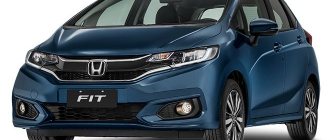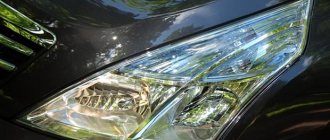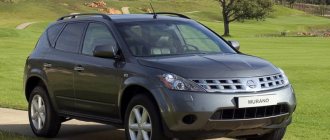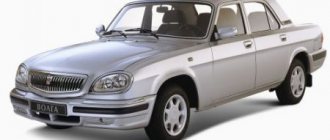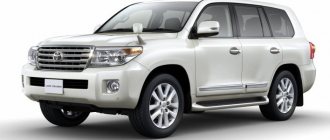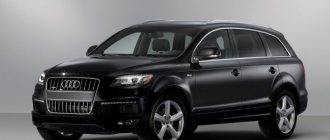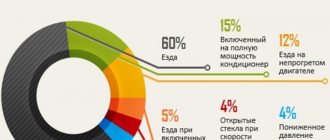This model, which is aimed at middle-class buyers, went on sale in 1990. Nissan Primera has always been produced in the following body styles: sedan, station wagon and hatchback. Over the entire period, two generation changes were made. The car has become very popular in our country, largely due to its availability and reliability. The production was discontinued in 2007, as demand for the car fell in many European countries.
Nissan Primera owner reviews
Generation 1
- Maxim, Nizhny Novgorod, 2.0, 76 l. With. diesel. The car is from 1996, with a mileage of 380 thousand km. Inherited from three previous owners, all of whom used the car as taxis. And I also decided to do the same with Primera. The car is more economical than powerful. There is no point in driving it fast, the average consumption is 8 liters per hundred.
- Sergey, Nikolaev, 1.6 90 l. With. petrol. The car was produced in 1990, according to the data from the original registration certificate. All documents were provided by the previous owner. I have no idea where he got the Primera from. Most likely, it was imported in the early 90s, like all the other auto junk. The car is from Japan, right-hand drive. Mileage 350 thousand km at the moment. I have a sedan version with a 1.6 90 horsepower engine. The car itself is light and accelerates very dynamically. The manual transmission still shifts gears confidently, acceleration to hundreds in 12 seconds is very good. Fuel consumption averages 10 liters per hundred. The design is simple, I service it myself.
- Dmitry, Minsk, 1.8, 125 l. With. petrol. The example was inherited from my father, the car was produced in 1996. Today the odometer shows 267 thousand miles, to be exact. Not a bad car, quite powerful and torquey. The gasoline engine produces 125 horses, and accelerates to hundreds in less than 10 seconds. But the car is not young, and I no longer pile it like my father. Although Examples still have potential. Eats on average 10-11 liters/100 km.
- Oleg, Novosibirsk, 2.0, 90 l. With. diesel. I'm happy with the car, a car for all occasions. Now I work in a taxi, in this job Primera reveals her full potential. Especially its 90-horsepower diesel engine, it is very economical. Eats 8 liters in the urban cycle.
Mikhail, Tambov, 1.8, 125 l. With. I liked the car, the stylish angular design of the 80s. In general, I am fascinated by rare cars of that time, not that now there are remnants like the Toyota Camry. My Example is equipped with a 1.8-liter gasoline engine and consumes 11 liters.
Generation 2
With 1.6 engine
- Alexey, St. Petersburg. The Nissan Primera is a decent car for its class, drives great and has grippy brakes. I would never have thought that the average, almost business class, cars were made with such sharp handling. The example obeys the steering wheel, no matter where I turn. The 1.6-liter gasoline engine consumes 10 liters with manual transmission.
- Mikhail, Krasnoyarsk. I liked the car. I praise Primera for its stylish and original design with the correct shapes. The car reminds me of a Nissan Maxima, which is good. Sporty silhouette, great potential for tuning work. Consumption is 11 liters with a 1.6 engine and manual gearbox.
- Anton, Novosibirsk. I bought a car in 2000, the mileage is now 180 thousand km. The design of the car is surprisingly simple; I repair it myself. If anything is serious, you can contact a company service station. Spare parts are inexpensive, absolutely all parts are available. The car has great potential for tuning. But I prefer to keep the Primera in its original form, because I like it better. The sedan is equipped with a 1.6-liter engine that consumes 10 liters of gasoline per 100 km. The car rides smoothly and is set up for a comfortable and leisurely ride. An impressive suspension, although of course it’s far from the Volga. I liked the car, not like the last third generation Primera, my friends have one.
- Vladimir, Penza. The car was produced in 2001, a comfortable and dynamic car for every day. Used in taxis. I am 99% satisfied with the car, if you do not pay attention to some shortcomings. For example, this is a 1.6 petrol engine. It consumes an average of 12 liters per hundred, which I think is a lot. The suspension is a bit harsh for our roads, but this is the price to pay for good handling.
- Yaroslav, Taganrog. A universal car, suitable for both the city and the highway. The example has already covered about 190 thousand km; I’ve been driving it since 2002. The sedan is equipped with a 1.6-liter engine and manual transmission, and consumes an average of 11 liters per 100 km.
With 1.8 engine
- Oleg, Novosibirsk. Nissan Primera is a car for those who need a comfortable family sedan for little money. I bought it second hand, with 160 thousand mileage. There are some breakdowns, but I don't really complain. I do the repairs myself, and the parts are inexpensive. Gasoline consumption with a 1.8 engine and manual transmission is 11 liters/100 km.
- Vasily, Kyiv. I have a 2002 Primera with a 1.8-liter engine. 115 horses is quite enough, and the car itself is quite light for its class, and therefore capable of a lot. It handles great, the chassis is tuned as it should. I praise Nissan for the original design outside and inside; in the cabin, all the controls are at your fingertips, and you don’t really need to get used to them. Knobs, buttons, etc. – everything is the old fashioned way, I like it. The 1.8-liter engine reaches the first hundred in 10 seconds, and the maximum speed is within 200 km/h, sometimes more. Gasoline consumption is 11 liters per 100 km.
- Marina, Ekaterinburg. The car was produced in 2001, my husband and I bought it as a sedan. A spacious and beautiful car, under the hood it has a lively 1.8-liter engine. The Primera consumes an average of 11 liters per hundred, I praise the car for its clear handling and tenacious brakes. The suspension is a bit stiff, but there is little roll.
- Svyatoslav, Irkutsk. The car is beautiful, no doubt about it. I'm talking about my configuration with a 1.8-liter engine. In my opinion, the engine is the key advantage of the second generation Examples. I've driven all three cars and liked this one the most. The third one is about nothing at all. My Example's gasoline consumption is 10 liters on average.
Other engines
- Daniil, Kaliningrad, 1.8, 115 l. With. I liked the car. I have a four-door sedan version, fuel consumption is 10 liters per 100 km. The sedan is equipped with a 5-speed manual transmission, the gearbox shifts smoothly. The cabin is noisy, but this is forgivable for a mileage of under 200 thousand km.
- Konstantin, Sverdlovsk, 2.0, 90 l. With. diesel. I'm happy with the car, a universal car for every day. As long as it doesn’t break, but in general there are plenty of breakdowns. There's always a set of pelvic guides in the trunk, so I'm calm. But I’m still proud that I drive a Japanese car. Consumption 8 liters.
- Elena, Penza, 2.0, 150 l. With. I found a Nissan Primera in good condition from a recent ad on the Internet. Diagnostics showed everything normal, you can take it. I liked the car, it consumes no more than 12 liters per hundred.
- Vladislav, Tambov. 2.0 150 l. With. This is one of my fastest cars, and also my favorite. They knew how to make cars before. When I get behind the wheel of an Example, nostalgia for those times awakens. I start the 150-horsepower unit, and the car seems to come to life. Vibrations all around, the front panel and door cards are shaking, crickets are waking up, etc. - it seems that the car will soon explode. But all this just adds drive, increases adrenaline and something else like that. I’m generally delighted that my Primera is still running. The odometer shows 413 thousand km, a major overhaul has been done. I don’t pile on as much as I did in my younger days. Still, this is already a rarity, after all. Eats an average of 12 liters per 100 km.
- Vitaly, St. Petersburg, 1.8 115 l. With. My relatives gave me a car; they were just about to buy another car. I was 100% satisfied with Primera. The 115-horsepower engine is easy to maintain, spare parts are inexpensive. Consumption is 8-11 liters of gasoline.
- Tatyana, Novosibirsk, 2.0 diesel. Primera is my first foreign car; before it there was a VAZ classic. So far I’m happy, it’s like I’m sitting in another world. Diesel 2.0 consumes 8 liters per 100 km.
- Dmitry, Moscow. 2.0 90 l. With. diesel. I liked the car, it handles and brakes great. An economical diesel engine consumes only 8 liters per 100 km, and there is no need to drive fast. The car is designed to give you a feeling of comfort while enjoying the city views while driving. I often travel around the center and admire the capital’s surroundings
- Igor, Arkhangelsk, 1.8 114 l. With. petrol. Nissan Primera produced in 2002, has already covered 285 thousand km. I will soon change to a Nissan X-Trail. Crossovers are king now, and sedans are dying out. The Primera was out of its era, but it was a worthy car. I ate 10 liters in the city, and 8 liters on the highway.
Generation 3
With engine 1.6 109 l. With.
- Nikolay, Dnepropetrovsk. The best thing about the Example is that it has a fairly fast 1.6-liter petrol engine that produces an acceptable 109 horsepower. Everything else is for everyone. The design is somehow artificial - like a toy or something. The dashboard in the center was initially perceived as a know-how, but in reality such a panel was just an eyesore. I didn’t like the car, but it eats a little – only 9 liters per 100 km. I still drive the Example and am putting it together for a new car.
- Elena, Novosibirsk. Overall I liked the car, but nothing more. There are shortcomings, but they appeared only after 100 thousand km of use. Consumption with a 1.6-liter engine reaches 10 liters/100 km.
- Olga, Nikolaev. I bought a Primera in 2003 and sold it in 2008. The car is completely unreliable, but I wanted Japanese quality. Only the gasoline consumption was impressive - 8-9 liters with a 1.6-liter engine.
- Konstantin, Penza. I bought a Nissan Primera in 2004, and at first I liked the car. Then I regretted that I bought a new one - I spent a lot of money. Moreover, the car is in a top-end configuration with such an engine. The car was quite expensive, and it was considered innovative by those standards. Stylish and unusual design, especially inside. The display on the center console, the full electrical package – all this impressed me at first glance. But after 50 thousand km the car began to crumble, out of the blue. It seems to be Japanese quality, and it breaks. The suspension collapsed and the fuel pump had to be replaced. The car is not intended for our roads, salty winter conditions, etc. The only thing I liked was the efficiency - in the city it was about 10 liters per 100 km.
- Dmitry, Vologda region. I bought the car for my wife, she just likes such stylish cars. The car is not bad in handling, and has a very economical 1.6-liter engine. Fuel consumption is 9-10 liters per hundred. The sedan turned out to be unreliable and often acted up. In the end, my wife gave it to me. I tinkered with Primera for about 50 thousand km, then I sold it, thank God. There were a ton of repair costs; in my opinion, this is the most unsuccessful car in Nissan history.
- Oleg, Ekaterinburg. The example was made in 2005 and I still drive it. I'm already used to its breakdowns. But it breaks down due to small things, nothing serious has happened for 100 thousand so far. I do repairs at a service center, spare parts are relatively inexpensive. I'm used to the car, so I'm not selling it yet. I know all its pros and cons, and what to expect from it. Gasoline consumption with a 1.6 engine is 10 liters.
With engine 1.8 116 l. With.
- Artem, Lipetsk. The car was produced in 2007, I bought it at a discount. The car was then discontinued, allegedly due to low reliability, and because of this no one bought it. But the price won me over and I took a chance. Like, this is a Japanese foreign car. Now my Primera is ten years old, I still drive it. Not a single major breakdown, I buy only original spare parts. I use the car carefully - in winter it lives in the garage, and during the rest of the year I drive it around the city properly. The 1.8 engine produces 116 horses and pleases with its dynamics and efficiency. In the city it comes out to 11 liters/100 km.
- Alexander, Peter. The Nissan Primer is a family car, rides comfortably and is adapted for Russian conditions. Maybe I’m just lucky - otherwise I have two friends who constantly complain that their Primera practically lives at the service station. Well, it’s okay, I’m fine so far. Consumption 11 liters/100 km.
- Alexey, Taganrog. I'm not happy with the car. Primera is the worst mistake of my life, just a nightmare. I dumped so much money into it, but it turned out to be not a car, but a bucket of bolts. Well, except that I regularly ate 10 liters per hundred, with a 1.8 engine and automatic transmission.
- Boris, St. Petersburg. Unfortunately, the car did not impress. Well, I only liked the fashionable design and comfortable interior, and the engine is very dynamic and economical in the city - it consumes an average of 10 liters per hundred. At the 50th thousand, the synchronizers began to crunch, and behind them the gearbox began to leak. At the 70th thousand, the fuel pump is in the firebox, the clutch disc is also in the firebox. In general, everything is bad. Sold and forgotten. Now I have a Volkswagen Jetta. How glad I am after all this hell, I’m just in seventh heaven.
- Vasily, Nizhny Novgorod region. The car often broke down, and I had no choice but to sell it. At that time, the odometer showed 70 thousand km. But on the other hand, it was a pity to part with Primera, it was my first Japanese one. In general, the impression of the Japanese auto industry is rather gloomy. The car had a 1.8-liter engine and consumed 10 liters. Eh, I’ll take a Toyota Corolla and let’s see how this Japanese girl behaves.
With 2.0 engine
- Margarita, Magnitogorsk. I liked the car, I drive it and have no complaints. The car breaks down, but I have a jack of all trades - my beloved husband. He is ready for anything for me - constantly in the garage, in fuel oil. Digging into my Example. The main thing for me is that the car is in good working order in the morning. At least the guy is doing well and the car is running. I’m at work from morning to night, so a car mechanic at home came in handy. The car consumes an average of 12 liters per 100 km. The 2-liter engine is energetic and loves high revs.
- Dmitry, Yaroslavl. The car was produced in 2006 and I still drive it. I would have sold it a long time ago if I had collected it for a Volkswagen Jetta, for example. I bought this bucket for my own head. It's right that Nissan discontinued it. Although it is not clear why to launch it into series, it was necessary to carry out preliminary tests, etc. Apparently few tests were carried out, but oh well. The car is a log, but still moving. And thanks for that. With a 2.0 engine it consumes 12 liters per 100 km.
- Anatoly, Orenburg. We still need to look for such cars. I bought it in the hope that if the car is Japanese, it means it is reliable. But in the end it turned out to be the opposite. In this car, I was satisfied with only the 1.8 engine - dynamic and economical, it consumed an average of 10 liters of gasoline.
- Julia, Krasnoyarsk. Nissan Primera is not a car for everyone, but for handy guys. I bought a car second hand and didn’t regret the money for it. Moreover, I bought it for next to nothing. Of course, there are breakdowns, the car is not new. The 1.8 engine works properly and consumes 11-12 liters. I service it at the dealer on time, buy original spare parts, everything is fine.
- Yana, Moscow region. A car for all occasions. Was. I bought it in 2006, there was no end to my joy. The car consumed 12 liters of gasoline and worked properly, like a starship. But then it couldn’t stand our roads and began to crumble. There were a lot of problems with electricity, wiring, etc. Our salty winters took their toll. I no longer had the strength, and then fate came for Primera - I got into a head-on accident, all the airbags worked as they should. The car cannot be restored. I was so happy, there are no words. I happily collected some money and moved to a Ford Focus.
Official consumption rate
The line of power units of the Examples includes a large number of different engines, the displacement of which varies from 1.6 to 2.5 liters in the third generation. The manufacturer has set different fuel consumption indicators for each engine.
First generation
Nissan Primera P10 became one of the most popular cars of its time. Available to the buyer to choose from, 1.6, 1.8, 2.0-liter engines paired with a manual transmission have been and remain the most popular. All-wheel drive was available for the first and last configurations, and the 1.8 engine was paired with a 4-speed automatic transmission. Official gasoline consumption:
- 1.6 engine paired with a manual – 8.5 l/5.5 l city/highway;
- 1.8 engine paired with a manual – 9.1 l/6 l city/highway;
- 1.8 engine paired with an automatic transmission – 10/7 liters in the urban/suburban cycle;
- Engine 2.0 – 12.5/9 l in urban/suburban cycle.
Second generation
With the release of the second generation, the range of engines available to choose from has not changed significantly. The only thing is that the manufacturer has improved the 1.6-liter Nissan Primera P11 engine and increased its power to 99 horsepower. A robotic transmission has also become available. Official gasoline consumption standards remained at the same level.
Third generation
In 2002, a modification of the Nissan Primera R12 was born, which has undergone significant changes. The manufacturer tried to reduce the actual level of fuel consumption, and the power of the 1.8-liter engine was also increased to 116 horsepower. Stated standards:
- Power unit 1.6 paired with mechanics – 7.3 l/5 l city/highway;
- Power unit 1.8 paired with mechanics – 7.9 l/5.5 l city/highway;
- 1.8 engine paired with an automatic transmission – 9.5/6 liters in the urban/suburban cycle;
- Engine 2.0 – 11.5/6.5 l in urban/suburban cycle.
Ways to save gas
Although the fuel consumption of the Nissan Primera cannot be called high, you can even save on it. Even if you cannot achieve consumption less than the basic technical specifications, you can prevent it from increasing.
Factors affecting fuel consumption
:
- owner's driving style;
- weather and seasonal conditions;
- engine type and size;
- car load;
- quality of fuel and oil for engine lubrication;
- presence of malfunctions or worn parts.
Over time, the amount of fuel the car uses increases. Experts say that with every 10,000 km of travel, fuel consumption increases by 15-20%.
